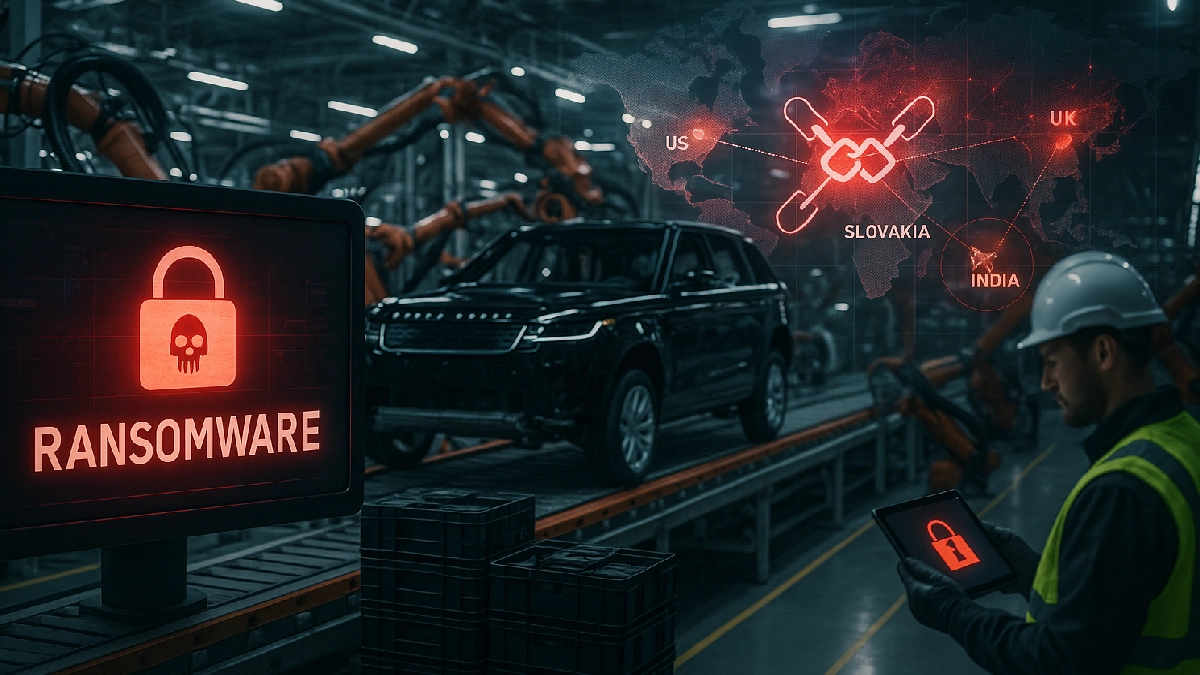A cyberattack at Jaguar Land Rover (JLR), Tata Motors’ UK-based marquee, didn’t just knock out servers—it stalled assembly lines, strained suppliers, rattled stock markets, and exposed a quiet systemic risk: modern automaking runs on digital glue that few insure properly. In less than a month, production halted across the UK, Slovakia, and India, with phased restarts slipping week by week as losses mounted and government assistance entered the conversation—an extraordinary step that underscores the macro stakes for national industry and jobs. This is what happens when a cyber event collides with a highly synchronized manufacturing ecosystem: operations stop, cash burns, suppliers wobble, and confidence shakes across borders.
What happened
- A ransomware-led cyber incident forced JLR to disable IT infrastructure and pause production at multiple plants, with disruptions persisting for weeks and sequential extensions announced as investigations and secure restart plans evolved.
- Reports suggest tens of millions in weekly losses, with external estimates noting potential impact approaching £2 billion, partly because JLR lacked cyber insurance, leaving the full burden on the company’s balance sheet.
- UK authorities and the National Cyber Security Centre coordinated with JLR, while ministers weighed supplier support to prevent cascading failures—an unusual public backstop for a private-sector cyber crisis.
Anatomy of the attack
- Investigations and industry analyses indicate a ransomware campaign using social engineering, credential theft, and lateral movement, with overlaps tied to threat clusters exploiting cloud and collaboration stacks.
- Earlier in the year, a separate group claimed to have leaked JLR-linked data via stolen project management credentials, highlighting how infostealer-led access can seed later operational disruption if not fully remediated.
- The broader Tata ecosystem was also probed: Tata Technologies disclosed a ransomware incident and later saw a large leak claim including documents and contracts, underscoring expanding threat perimeters in engineering supply chains.
Why it became systemic
- Automotive manufacturing is a choreography of just-in-time parts, precision scheduling, and software-defined processes; once core IT is compromised, stoppages propagate from plants to tiered suppliers to dealer networks.
- JLR supports a large job base directly and indirectly, so a prolonged outage imperils smaller suppliers’ liquidity, prompting union and government concern about insolvencies and the need for emergency stabilization.
- Markets internalized the shock quickly as investors priced in uninsured losses and downtime at a unit contributing the bulk of consolidated revenue.
The insurance blind spot
- JLR reportedly lacked active cyber insurance at the time, transforming an operational crisis into a balance-sheet event that could erase a year’s profit.
- Attempts to secure coverage were reportedly underway pre-incident, spotlighting procurement friction and timing risk in cyber underwriting for complex, OT-heavy manufacturers.
- The episode is a cautionary tale: cyber exposure isn’t just data privacy—it is physical output, working capital, and counterparty solvency, which standard insurance stacks may not adequately cover without specialist riders.
Supply chain fracture points
- Tier-1 and tier-2 suppliers across production geographies faced disruption tied to paused JLR lines, with quality assurance operations idled as production halted.
- Smaller firms lack the buffers that OEMs enjoy; weeks without call-offs can trigger layoffs, covenant breaches, or failures, forcing upstream OEMs and governments to consider bridging support.
- Once confidence erodes, bullwhip effects emerge—inventory mismatches, expedited freight on restarts, and overtime premiums—amplifying cost even after systems return.
Playbook of modern attackers
- Threat actors increasingly stitch together social engineering, infostealers, MFA fatigue, and cloud app exploits to gain footholds, then blend malicious traffic with normal flows and use anonymization to cover data theft, complicating detection.
- Ransomware groups diversify: access brokers harvest credentials, affiliates deploy payloads, and branding shifts as crews reconstitute, making attribution fluid and defenses reactive.
- The auto sector has been flagged after other platform-level disruptions, demonstrating vendor risk and the appeal of large, interconnected ecosystems.
What JLR did right—and what’s next
- JLR paused production to contain risk, worked with national cybersecurity authorities and law enforcement, and communicated staged restart timelines—core crisis hygiene even if costly in the short run.
- The company acknowledged potential data compromise and signaled regulatory notifications, aligning with evolving expectations for transparency during operational cyber incidents.
- The near-term path likely includes phased restarts, supplier triage, capital allocation to remediation, and a revisit of cyber insurance and resilience investments across IT and OT.
Actionable lessons for industry
- Treat OT and IT as one blast radius: unify monitoring, incident response, and tabletop exercises across plant networks and cloud apps tied to production planning and MES.
- Harden identity: rotate and vault credentials, enforce phishing-resistant MFA, monitor for infostealer logs in criminal markets, and segment privileges to slow lateral movement.
- Stress-test suppliers: pre-arrange emergency financing lines, dual-source critical components, and map second- and third-tier exposure to avoid single points of failure in restarts.
The bigger picture
- National industrial strategy now includes cyber business continuity; even the consideration of government support for a private cyber aftermath signals a policy pivot for systemic manufacturers.
- Capital markets will likely price uninsured cyber tail risk into OEM valuations, rewarding firms with demonstrable resilience programs and quantifiably reduced downtime exposure.
- For conglomerates, cross-subsidiary posture matters: breaches at engineering service arms can echo into OEMs, pushing group-wide standards for credential hygiene and third-party risk.
Last Updated on October 18, 2025 by Lucy




